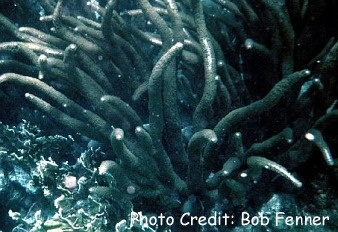
By Bob Goemans


Likely Reef Tank Suitable
Likely Fish-Only Tank Suitable
Gorgonians are in the Class Anthozoa. Further division shows them in the Subclass Octocorallia, Order Alcyonacea (soft corals, stoloniferans, gorgonians) and finally found in the Suborders Calcaxonia, Holaxonia, and Scleraxonia. These suborders contain all sea whips, sea fans, sea rods, and sea blades. Most have a firm interior axial skeleton, usually a very pliable proteinaceous compound called Gorgonin or possibly a calcareous compound, which are then covered with tissue. Each suborder will be shown separately.
By far this is a larger suborder than the suborder Scleraxonia with species coming from both oceans; however, those coming from the Caribbean are of special interest to aquarists, as they are photosynthetic species requiring bright light and good water movement. Those of special interest are in the Caribbean families Plexauride and Gorgoniidae.
The Flamingo Tongue, Cyphoma gibbosum, a very pretty mollusk from the Caribbean, is fond of eating gorgonian tissue/polyps. Also, keep your gorgonian specimens out of the range of stinging corals, e.g., Bubble, Elegance, and Hammer corals.
Furthermore, only a specimen that is attached to a piece of rock should be purchased. If the main stem is not attached to some form of substrate, the entire specimen could deteriorate rather rapidly. An epoxy putty can be use to anchor their base should it not already be attached to a piece of rock. Specimens having blackened tissue or where the horny skeleton shows through should not be purchased.
Some gorgonian can possibly grow to the water's surface where they form ball-shape tips. Usually, they will branch-out under this bulbous tip and the aquarist can cut the branch, about two inches (5 cm) below the water surface and secure the new stem elsewhere in the aquarium with underwater epoxy to form a new specimen.
Both photosynthetic and non-photosynthetic species consume plankton-like foodstuffs, e.g., rotifers, baby brine shrimp, and various commercially prepared plankton-like foods.